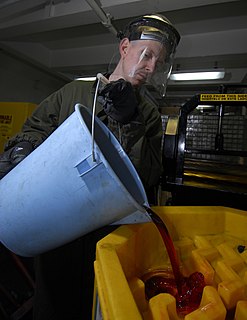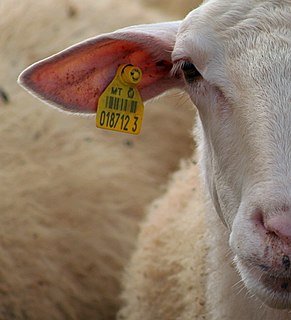
Aerospace is the human effort in science, engineering and business to fly in the atmosphere of Earth (aeronautics) and surrounding space (astronautics). Aerospace organizations research, design, manufacture, operate, or maintain aircraft or spacecraft. Aerospace activity is very diverse, with a multitude of commercial, industrial and military applications.
Radio-frequency identification (RFID) uses electromagnetic fields to automatically identify and track tags attached to objects. The tags contain electronically-stored information. Passive tags collect energy from a nearby RFID reader's interrogating radio waves. Active tags have a local power source and may operate hundreds of meters from the RFID reader. Unlike a barcode, the tag need not be within the line of sight of the reader, so it may be embedded in the tracked object. RFID is one method of automatic identification and data capture (AIDC).
Passivation, in physical chemistry and engineering, refers to a material becoming "passive," that is, less affected or corroded by the environment of future use. Passivation involves creation of an outer layer of shield material that is applied as a microcoating, created by chemical reaction with the base material, or allowed to build from spontaneous oxidation in the air. As a technique, passivation is the use of a light coat of a protective material, such as metal oxide, to create a shell against corrosion. Passivation can occur only in certain conditions, and is used in microelectronics to enhance silicon. The technique of passivation strengthens and preserves the appearance of metallics. In electrochemical treatment of water, passivation reduces the effectiveness of the treatment by increasing the circuit resistance, and active measures are typically used to overcome this effect, the most common being polarity reversal, which results in limited rejection of the fouling layer. Other proprietary systems to avoid electrode passivation, several discussed below, are the subject of ongoing research and development.

A hydraulic fluid or hydraulic liquid is the medium by which power is transferred in hydraulic machinery. Common hydraulic fluids are based on mineral oil or water. Examples of equipment that might use hydraulic fluids are excavators and backhoes, hydraulic brakes, power steering systems, transmissions, garbage trucks, aircraft flight control systems, lifts, and industrial machinery.

The Electronic Product Code (EPC) is designed as a universal identifier that provides a unique identity for every physical object anywhere in the world, for all time. The EPC structure is defined in the EPCglobal Tag Data Standard, which is an open standard freely available for download from the website of EPCglobal, Inc.. The canonical representation of an EPC is a URI, namely the 'pure-identity URI' representation that is intended for use when referring to a specific physical object in communications about EPCs among information systems and business application software. The EPCglobal Tag Data Standard also defines additional representations of an EPC identifier, such as the tag-encoding URI format and a compact binary format suitable for storing an EPC identifier efficiently within RFID tags. The EPCglobal Tag Data Standard defines the structure of the URI syntax and binary format, as well as the encoding and decoding rules to allow conversion between these representations. The EPC is designed as a flexible framework that can support many existing coding schemes, including many coding schemes currently in use with barcode technology. EPC identifiers currently support 7 identification keys from the GS1 system of identifiers, as well as a General Identifier and EPC identifiers that can be used for encoding supplies to the US Department of Defense.

An O-ring, also known as a packing, or a toric joint, is a mechanical gasket in the shape of a torus; it is a loop of elastomer with a round cross-section, designed to be seated in a groove and compressed during assembly between two or more parts, creating a seal at the interface.
Aeronautical Radio, Incorporated (ARINC), established in 1929, is a major provider of transport communications and systems engineering solutions for eight industries: aviation, airports, defense, government, healthcare, networks, security, and transportation. ARINC has installed computer data networks in police cars and railroad cars and also maintains the standards for line-replaceable units.

An ear tag is a plastic or metal object used for identification of domestic livestock and other animals. If the ear tag uses Radio Frequency Identification Device (RFID) technology it is referred to as an electronic ear tag. Electronic ear tags conform to international standards ISO 11784 and ISO 11785 working at 134.2 kHz, as well as ISO/IEC 18000-6C operating in the UHF spectrum. There are other non-standard systems such as Destron working at 125 kHz. Although there are many shapes of ear tags, the main types in current use are as follows:
ATA Spec 100 and iSpec 2200 are information standards for aviation maintenance and flight operations published by Airlines for America.
ARP4754, Aerospace Recommended Practice (ARP) ARP4754A, is a guideline from SAE International, dealing with the development processes which support certification of Aircraft systems, addressing "the complete aircraft development cycle, from systems requirements through systems verification." Revision A was released in December 2010. It was recognized by the FAA in AC 20-174 published November 2011. EUROCAE jointly issues the document as ED–79.

Swift Engineering is an American engineering firm, most notable for producing racing cars for a variety of open-wheel racing series, including Formula Ford, Formula Atlantic, the Champ Car World Series and Formula Nippon. From 2000 it diversified into Aerospace/Aviation markets.
AS9100 is a widely adopted and standardized quality management system for the aerospace industry. It was released in October, 1999, by the Society of Automotive Engineers and the European Association of Aerospace Industries.

Airlines for America (A4A), formerly known as Air Transport Association of America (ATA), is an American trade association and lobbying group based in Washington, D.C. that represents the largest airlines. A4A member airlines and their affiliates transport more than 90 percent of U.S. airline passenger and cargo traffic.
This is presented as one of the products of the enterprise software company SAP SE in its List of SAP products.
A specification often refers to a set of documented requirements to be satisfied by a material, design, product, or service. A specification is often a type of technical standard.
Network Centric Product Support (NCPS) is an early application of an Internet of Things (IoT) computer architecture developed to leverage new information technologies and global networks to assist in managing maintenance, support and supply chain of complex products made up of one or more complex systems, such as in a mobile aircraft fleet or fixed location assets such as in building systems. This is accomplished by establishing digital threads connecting the physical deployed subsystem with its design Digital Twins virtual model by embedding intelligence through networked micro-web servers that also function as a computer workstation within each subsystem component or other controller and enabling 2-way communications using existing Internet technologies and communications networks - thus allowing for the extension of a product lifecycle management (PLM) system into a mobile, deployed product at the subsystem level in real time. NCPS can be considered to be the support flip side of Network-centric warfare, as this approach goes beyond traditional logistics and aftermarket support functions by taking a complex adaptive system management approach and integrating field maintenance and logistics in a unified factory and field environment. Its evolution began out of insights gained by CDR Dave Loda (USNR) from Network Centric Warfare-based fleet battle experimentation at the US Naval Warfare Development Command (NWDC) in the late 1990s, who later lead commercial research efforts of NCPS in aviation at United Technologies Corporation. Interaction with the MIT Auto-ID Labs, EPCglobal, the Air Transport Association of America ATA Spec 100/iSpec 2200 and other consortium pioneering the emerging machine to machine Internet of Things (IoT) architecture contributed to the evolution of NCPS.
Real-time locating systems (RTLS) are used to automatically identify and track the location of objects or people in real time, usually within a building or other contained area. Wireless RTLS tags are attached to objects or worn by people, and in most RTLS, fixed reference points receive wireless signals from tags to determine their location. Examples of real-time locating systems include tracking automobiles through an assembly line, locating pallets of merchandise in a warehouse, or finding medical equipment in a hospital.
Produce traceability makes it possible to track produce from its point of origin to a retail location where it is purchased by consumers.
ISO/IEC 20248Automatic Identification and Data Capture Techniques – Data Structures – Digital Signature Meta Structure is an international standard specification under development by ISO/IEC JTC1 SC31 WG2. This development is an extension of SANS 1368, which is the current published specification. ISO/IEC 20248 and SANS 1368 are equivalent standard specifications. SANS 1368 is a South African national standard developed by the South African Bureau of Standards.









